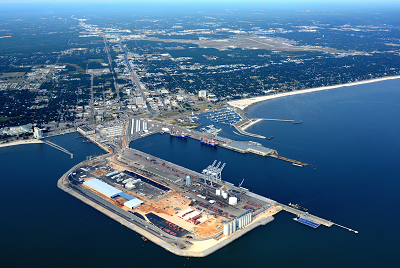

Water transportation has a number of advantages. It uses less energy, therefore the dual benefits to businesses of environmental responsibility and substantial cost savings can be realized. According to the Kentucky Association of Riverports, one gallon of fuel can move one ton of cargo 514 miles by barge compared to 202 miles by train and only 59 miles by truck. In addition, it’s significantly safer than truck or rail, with the fewest number of accidents reported.
Around the country, ports are not just moving commodities and goods, bringing benefits to business and the job market; they are also driving growth in the communities that surround them. To see how that happens, take a look at the following, which are just a few select examples of ports in action.
Port of South Louisiana
Tremendous growth along the Mississippi River
According to the Port of South Louisiana’s quarterly report, Paul Aucoin, executive director, is pleased with the economic development boom

Plus, more growth is likely in the works. The Formosa Petrochemical Corporation announced the launch of a feasibility study for a potential $9.4 billion industrial complex in St. James Parish. And the Port of South Louisiana received an Economic Development Administration (EDA) award of $250,000 for a container terminal strategic planning and marketing study.
According to Aucoin, new investment in the Port district, to date, is over $23 billion, which will bring 4,000 jobs available for area residents.
“In my opinion, the Mississippi River is our state’s greatest natural resource,” said Aucoin.
Yellow Creek State Inland Port, Iuka, Mississippi
Moving commodities is big business on river networks

The port terminal handles a wide range of commodities such as steel coils, steel plate, large fabricated steel items, steel pipe, coal and silicon. With water, rail and highway connections, the Yellow Creek Port is the most significant steel coil-handling facility in the Mid-South. Additionally, the port has six acres of outdoor storage and a 21-car capacity rail yard. In fiscal year 2016, the port moved 420,000-plus tons through the terminal.
Yellow Creek Port serves companies located in 10 states. Some of its tenants include Ergon Terminaling, FerrouSouth, Roll Form Group, Skyline Steel, Contract Fabricators, Hago Automotive and Mississippi Silicon.
“The port’s location gives our tenants an advantage by providing water transportation which allows for larger shipments of material,” said Yellow Creek State Inland Port Authority Executive Director Robert Dexter. “A barge load is equivalent to about 60 truck loads,” he added.
The Port of Savannah, Georgia
The gateway to the Southeast delivers goods and jobs
The Port of Savannah’s Garden City Terminal handles containerized trade ranging from retail goods to parts for manufacturing, fresh and frozen food, and commodities such as forest products and grain.

With 1,200 acres and nearly 10,000 feet of contiguous berth space, the size and scope of Garden City Terminal creates choice and flexibility for the customer.
The Port of Savannah drives economic expansion by providing more efficient and cost-effective access to international markets, extending the reach of business through direct interstate connections, on-terminal rail and the most container ship services in the U.S. Southeast.
In fiscal year 2016 alone, port-related manufacturing and logistics companies announced more than half a billion dollars in investment, bringing nearly 3,500 jobs and well over five million square feet of development to the state.
Home Depot, Lowe’s and Walmart are among many retail outlets with distribution centers in Savannah that supply stores across a multi-state region. The companies benefit through efficient port services, delivering cargo close to important inland markets. The Port of Savannah also moves parts for several automakers across the Southeast, including Kia Motors Manufacturing Georgia.
Kia recently partnered with Cordele Intermodal Services (CIS), which operates Georgia’s first inland port. CIS will handle up to 30,000 TEUs per year to supply the Kia manufacturing plant in West Point, Georgia. This partnership will save more than six million truck miles each year.
“The Southeastern U.S. is experiencing a faster rate of population growth than any other region of the country. This population increase is spurring a related growth in demand for goods,” said Griff Lynch, executive director of the Georgia Ports Authority. “Cargo owners seeking to efficiently serve this region are increasingly turning to the Port of Savannah as the gateway port to the Southeast.”
Additionally, shipping lines are moving to larger, more efficient vessels. Featuring 22 ship-to-shore cranes and 146 rubber-tired gantry cranes, the Port of Savannah is uniquely equipped to handle the massive exchanges associated with neopanamax vessels.
The Paulsboro Marine Terminal, New Jersey
Transforming a blighted site into an economic driver
The Paulsboro Marine Terminal, or Port of Paulsboro as it is commonly called, was a former BP tank farm that is going to be the first major multi-purpose port constructed on the Delaware River in the last 50 years. The completed site will encompass 190 acres of waterfront land, and ultimately 2,600 linear feet of berth, on the Delaware River.
Additional infrastructure improvements to the site include a dedicated bridge and off-ramp that connects directly to I-295 to divert truck traffic and bypass residential neighborhoods, and approximately four miles of rail track onsite. NLKN is the first tenant at the Paulsboro Marine Terminal. It is the largest producer of steel in Russia and headquartered in western Pennsylvania.
In addition to port tenants, the Port of Paulsboro is benefitting the local business community in a number of ways. The Paulsboro Railroad Company, a local company, received the contract to build the rail at the port. The port also spurred a recently approved redevelopment project and part of the project includes a new grocery store that will be a job creator.
“The trend in the area is to use the tools of redevelopment to transform a blighted property into a sustainable economic driver for the region and taking into consideration the impact on the local community,” said Thomas Bianco, Gloucester County director of economic development. “The dedicated bridge access to 295 allows companies direct access to the port with minimal impact to the surrounding community. Also, the direct rail access allows the tenants to unload the cargo off the vessel more efficiently, which will get it to the company quicker.”
The Port of Gulfport, Mississippi
A busy port is a huge economic catalyst for the region

Because it has easy access to open ocean waters via an 18-mile ship channel that is maintained at 11 meters of depth, it is ideal for ocean freight carriers serving Mexico, the Caribbean and especially Central and South America. The Port is located within close proximity of the major east-west corridor of Interstate 10 and has direct on-dock rail service provided by the Kansas City Southern Railway.
The Port’s business development and diversification efforts are making significant strides toward the goal of positioning the Port of Gulfport as an important economic catalyst for the surrounding community and the region. The Port of Gulfport currently has eight maritime tenants including Dole Food Company, Crowley Maritime Corporation, Chemours, Chiquita Fresh North America, Gulf Coast Shipyard Group, Inc., McDermott International, Inc., Topship, LLC and The University of Southern Mississippi. The Port also has one non-maritime tenant, Island View Casino Resort.
The Port of Gulfport handles refrigerated items such as fruit and frozen poultry and pork, and containerized items such as apparel, paper, cotton, automobiles and road-building machinery. It also handles bulk Ilmenite ore, crushed limestone and break-bulk. The Port recently handled a large machinery press for the automobile industry and has exported patrol boats manufactured in Mississippi that were being shipped overseas.
“We are coming to the end of our $570 million restoration and expansion program, which in turn helped us develop more land to provide for our customers. The addition of more land and new facilities has allowed for our tenants to expand their operations at the Port, further increasing our tonnage numbers,” said Jonathan Daniels, CEO and executive director of the Port of Gulfport. “This multifaceted project paves the way for dynamic new economic opportunities for the port, for businesses and for the community.”
With the completion of an 84-acre addition, the Port of Gulfport now spans 300 acres. The comprehensive restoration program includes the construction of wharfs, terminals, container storage, cranes and intermodal container transfer facilities.
Related Agencies
- St. John the Baptist Parish Economic Development
- Port of South Louisiana
- St. James Parish Economic Development Department
- Mississippi Development Authority
- Savannah Economic Development Authority
- Georgia Department of Economic Development
- Georgia Ports Authority
- Gloucester County Department of Economic Development
- New Jersey Commerce, Economic Growth, and Tourism Commission
- Mississippi State Port Authority - Port of Gulfport

